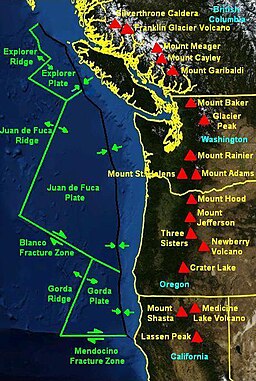Cascade Volcanoes
| Cascades Volcanoes | |
| Volcanic arc | |
|
Mount Rainier from the northeast
|
|
| Countries | United States, Canada |
|---|---|
| Provinces/States | Oregon, Washington, California, British Columbia |
| Highest point | Mount Rainier |
| - elevation | 14,411 ft (4,392 m) |
| - coordinates | 46°51′1.9″N 121°45′35.6″W / 46.850528°N 121.759889°W |
| Period | Eocene-to-Holocene |
The Cascade Volcanoes (also known as the Cascade Volcanic Arc or the Cascade Arc) are a number of volcanoes in a volcanic arc in western North America, extending from southwestern British Columbia through Washington and Oregon to Northern California, a distance of well over 700 miles (1,100 km). The arc has formed due to subduction along the Cascadia subduction zone. Although taking its name from the Cascade Range, this term is a geologic grouping rather than a geographic one, and the Cascade Volcanoes extend north into the Coast Mountains, past the Fraser River which is the northward limit of the Cascade Range proper.
Some of the major cities along the length of the arc include Portland, Seattle, and Vancouver, and the population in the region exceeds 10,000,000 people. All could be potentially affected by volcanic activity and great subduction-zone earthquakes along the arc. Because the population of the Pacific Northwest is rapidly increasing, the Cascade volcanoes are some of the most dangerous, due to their eruptive history and potential for future eruptions, and because they are underlain by weak, hydrothermally altered volcanic rocks that are susceptible to failure. Consequently, Mount Rainier is one of the Decade Volcanoes identified by the International Association of Volcanology and Chemistry of the Earth's Interior (IAVCEI) as being worthy of particular study, due to the danger it poses to Seattle and Tacoma. Many large, long-runout landslides originating on Cascade volcanoes have inundated valleys tens of kilometers from their sources, and some of the inundated areas now support large populations.
...
Wikipedia


